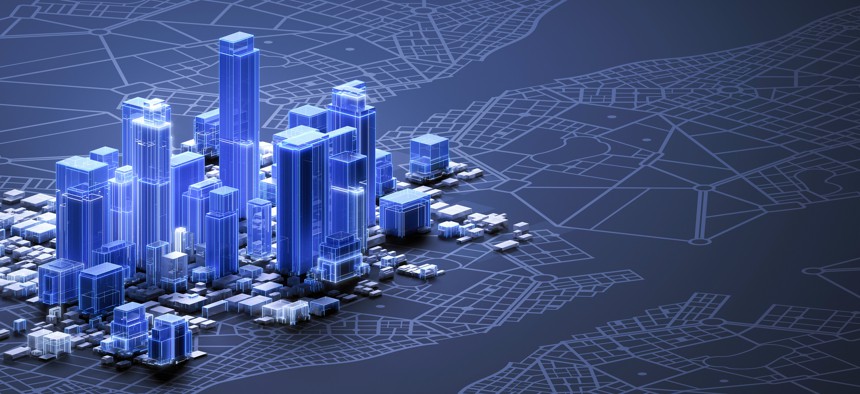Digital twins: Debunking 4 common myths

Maxiphoto/Getty Images
COMMENTARY | State and local agencies can use digital twins to run detailed analysis of planned roadways, housing developments and facilities to spot hidden issues.
Cities are experimenting with digital twins, the electronic replicas of an individual building, housing developments and infrastructure entities that can help city leaders simulate changing conditions and outcomes. But the wide-ranging applications of this new technology have led to many common misconceptions about digital twins. Let’s take a look at four big myths.
Myth #1: Digital twins are purely 3D models.
Whether for urban planning, environmental protection or securing a large event, a digital twin typically captures a continuous flow of real-time data from connected devices and creates a visual representation of the subject’s operational characteristics.
That makes digital twins far more than 3D models or visual representations of physical objects.
While visualization is an essential aspect, digital twins’ ability to incorporate data, create simulations and run analytics allows them to provide advanced insights and support decision-making. They use artificial intelligence and machine learning to identify patterns, trends, anomalies and correlations within the data and help officials make informed decisions and take proactive actions. For example, a digital twin of a city’s planned public transportation project showing traffic flow, building hazards and natural barriers can inform decisions by investors, architects and policymakers.
Myth #2: Digital twins are only useful for large organizations.
Some believe that digital twins are reserved for large enterprises with substantial resources and budget due to the buzz around cost and usability. However, cloud-based platforms, scalable technologies and cost-effective solutions have made digital twin adoption more accessible to smaller organizations as well.
In fact, digital twins may be more useful at a smaller level. A small city’s planning and development office, for example, can use digital twins to save time and money on building construction and transportation planning. By visualizing how new construction will affect the neighborhood, officials can see how the changing environment will impact transportation over time. A bigger city might not see the same level of benefit, since its planning department is likely to have a wider range (and larger number) of skilled employees.
Myth #3: Digital twins are only for engineers and technical experts.
This misconception has often caused an overall hesitancy toward new technology, so finding a digital twin company that offers a user-friendly, collaborative experience can help make the technology more digestible. An experienced partner can also guide staff through the implementation process, highlight valuable insights and enable collaboration between different departments or disciplines to make sure the technology is being used effectively.
Myth #4: Digital twins are too expensive.
The cost of implementing a digital twin can vary depending on the complexity of the system, the level of detail required, the amount and quality of data available and the specific requirements of the organization. While there can be costs associated with developing and maintaining a digital twin, there are ways to minimize expenses.
Agencies should start by clearly defining goals and objectives and by focusing resources on the areas that provide the most value. A pilot project will help validate the concept and identify cost-saving measures before scaling up. Prioritizing relevant and high-quality data integration will help agencies avoid the time and money spent on unnecessary data collection.
Digital twins have been widely misunderstood, but by learning more about the technology, state and local leaders can make informed decisions and embrace technological advances that enable growth and success.
Nilson Kufus is co-founder and CEO of Nomoko.
NEXT STORY: Giving AI direct control over anything is a bad idea—here’s how it could do us real harm





